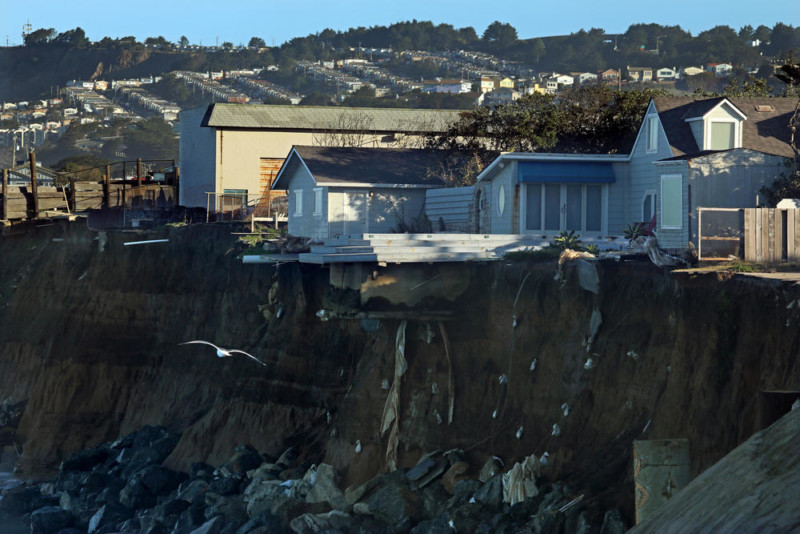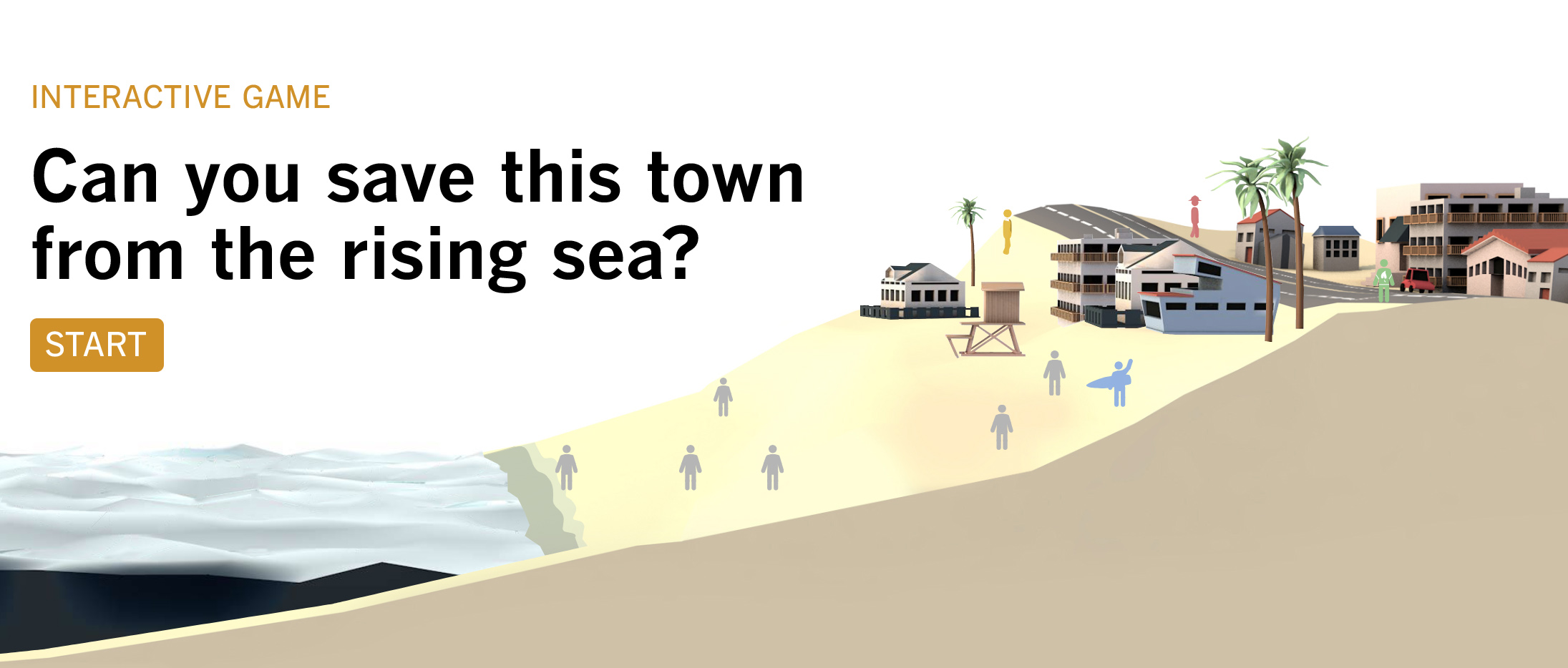For the tens of thousands who live and work along the California coast, no issue looms as large as sea-level rise. Since Rosanna Xia joined the Los Angeles Times in 2010, this symptom of climate change has dominated her coastal beat. “Everyone acknowledges the problem,” she says. “The water is rising, but what we’ve built and treasured along the coast is fixed in place with nowhere to go. What do we do?”
For those whose property and way of life are at risk, the discussion is overwhelmed by emotional attachments to place and home. The majority of locals who are unwilling to act on foresight endlessly debate their options, Xia says. The scientists she speaks to, however, all say that those options are grimly limited. For Xia, this poses a problem, one shared by many journalists attempting to report on the vast and, for now, mainly abstract effects of climate change: how might reporters communicate the entwined complexities of a social, political, and ecological story that, aside from melting glaciers and extreme weather events, is based on a catastrophe that is yet to occur?
Xia brought her problem to Ben Muessig, the Times’s technology and business editor. Together, they reviewed Xia’s notes and discussed ways to present the choices available. Sea-level rise, Xia told Muessig, struck many residents as an issue they could solve. “That’s when it hit us,” she says. “Why not create a game?”
Play The Ocean Game! And see if you can overcome the slow-moving disaster of sea level rise. https://t.co/r7RRWguxTH pic.twitter.com/eHgNg6nsxK
— Los Angeles Times (@latimes) July 8, 2019
“The Ocean Game,” published in July, is interactive journalism that places readers in charge of a coastal California town in danger of being washed away by the sea. You have eight “turns” in which to save the community. To do so, you may allocate your limited budget to a range of potential solutions such as building rock walls, extending the beach with sand, or attempting to buy up houses in order to relocate residents inland.
“We holed up in a conference room for days and mapped out the decision tree with sticky notes,” says Xia, who worked with Swetha Kannan, a data and graphics journalist, and Terry Castleman, a programmer and “engineer journalist,” of the team’s design process. “Building this game required the same reporting you’d need for any explanatory article: understanding the stakes and nuances to a point where you can break it down simply.” The game was accompanied by a written story to “anchor the project,” and further supported by photography, video, and data visualization. “Together, the multi-media package told the story of sea level rise adaptation in California,” Xia says.

Homes along the cliffs of Pacifica, California, where some residences have already been condemned or removed. Photo by Carolyn Cole / Los Angeles Times
“The Ocean Game” is not the first interactive project to focus on the effects of climate change. During the past two decades, numerous non-profit organizations and public entities have created climate change-focused games designed to communicate abstract issues in meaningful ways. “World Without Oil,” an alternate-reality game that asked players to plan for and engineer solutions to a possible near-future global oil shortage, ran across the internet on various blogs and social media services, like a kind of digital treasure hunt, for a few weeks in 2007, before the issue of oil shortages disappeared from the headlines entirely. In “Climate Challenge,” launched the same year, players attempt to reduce Europe’s carbon emissions. In “Stop Disasters,” players must save lives in the aftermath of various climate-derived disasters, including earthquakes and tsunamis.
Other media organizations have followed suit, with quizzes (such as The New York Times’ “Can You Guess What America Will Look Like in 10,000 Years?”) and full-fledged games. Such newsgames, as the genre is often known, engage concerns beyond the climate crisis; in recent years, outlets have published games based on reporting about asylum-seeking, the decline of American shopping malls, and the challenges of the gig economy.
“Some complex issues can be communicated more clearly in a dynamic and interactive form,” says Paolo Perdicini, a professor of digital media production and experimental game design at the School of Art at Carnegie Mellon University. “In the case of climate change, it’s hard to tell a story about infrastructural changes, or cascading ecological effects, or nonlinear phenomena. Games, by virtue of being dynamic and complex systems, have the potential to make us think about complexity. They can compress time, abstract perspectives, and acquaint us with unthinkable numbers and non-intuitive relationships.”
To help readers visualize some of those unthinkable numbers, in 2017 The New York Times published an online game titled “You Fix It: Can You Stay Within the World’s Carbon Budget?” In the game, players must reduce the carbon output of various countries in order to bring CO2 emissions to within the “safe limit.” Players choose the extent to which they will reduce emissions on a per-country basis; the game presents a final tally to demonstrate whether or not these choices have sufficiently reduced emissions in order to mitigate the worst effects of human-made climate change.
“There’s lots of data out there,” says Times visual journalism director Stuart A. Thompson, who worked on the game. “We thought there was a clear story that could walk people through climate cuts and help them discover what’s needed to really meet emissions targets. When you play…you realize pretty quickly we need to make much more drastic cuts than one might assume.”
“You Fix It” was co-created with a group of scientists from Climate Interactive, a Washington DC-based think tank The company has created numerous game-like simulations that model the effects of climate change and demonstrate the effectiveness of potential solutions. When, in 2017, President Trump reneged on the Paris climate agreement, the international accord designed to reduce emissions of greenhouse gases, Climate Interactive supplied the Times with data to illustrate the effects of that decision. “That’s when we decided to create a game that would help show readers the enormity of the challenge that the international community currently faces,” says Ellie Johnston, who runs Climate Interactive’s engagement programs, and liaises with national journalists on how best to present the company’s data. (The New York Times did not pay for the work Climate Change provided for “You Fix It”; Climate Interactive is principally funded by philanthropists)
“You Fix It” illustrates the scale of collaborative action that must be taken, but little else. If reducing CO2 emissions on a national scale was as straightforward as using a drop-down menu, consequence-free, only the most belligerent leaders would prevaricate. The challenge facing countries hoping to implement change is multifaceted.
“This project asks a lot from people,” says Thompson, of the Times’s decision to keep the game’s focus narrow and, arguably, shallow. “They have to orient themselves around the graphic, grasp the premise, grasp the conceit, grasp the interaction, understand the effects of their interaction, and understand what those effects mean. This isn’t the be-all end-all of climate stories. This is just two things: How much do we need to reduce emissions, and what will it take to get there? There are hundreds of stories in the world addressing how to do it.”
Building this game required the same reporting you’d need for any explanatory article: understanding the stakes and nuances to a point where you can break it down simply
Ian Bogost, Professor of Interactive Computing at Georgia Tech who co-wrote Newsgames: Journalism at Play, agrees that a simpler approach is often more effective. “We have this correct idea that when people interact they have skin in the game, as it were,” he says. “But the complexity makes it easier to bounce off games, especially when there are so many written stories and videos that require less effort.” There is also a risk, Bogost says, that a newsgame is seen as little more than a curiosity, and is referred to not for its content but rather for its relevance as a media-business story. “For that to go away, we need more prevalence of these games, more examples of media organizations getting them right—especially simplifying and tying the game back to citable content, so players can better understand the data that the game is based on.”
Despite some scepticism, Bogost remains hopeful that games can play a useful role in climate journalism. “People are currently overwhelmed with questions about the subject: Where should I start? Does it matter if I change to an electric car, or eat a different meat? Is the problem completely systemic, or can my actions have an effect? A good game would not seek to resolve these questions, but rather show the complexity while overcoming the media’s desire to show the easy solution.”
The audience response to “The Ocean Game” exceeded expectations at the Times. Nearly half a million people visited the sea-level-rise article and game, according to Xia, and the paper’s managing editor says the project resulted in more than 125 digital subscriptions.The game was “extremely well-received by readers,” Xia says, describing player feedback as “inspiring.”
Most encouraging for Xia, who has spent years watching the scientific community and coastal community often at loggerheads, was a new spirit of collaboration. Last month, The California Coastal Commission, the agency in charge of regulating the state’s coastline, held a workshop with city and county officials to discuss, among other things, sea-level rise. During the meeting, which Xia describes as considerably less heated than previous ones, county supervisor Bruce Gibson praised the LA Times project for revealing how narrowly he had been thinking about the problem. (Gibson’s comments can be seen at 02:04:00 in this video.) The game, she says, encouraged “policymakers, scientists, and residents across the state [to talk] about their similarities rather than their differences.”
Simon Parkin is a contributing writer for the New Yorker, a critic for The Observer newspaper and author of the forthcoming narrative non-fiction book A Game of Birds and Wolves.

